MBA403 Financial Analysis Report: BHP Billiton Financial Performance
VerifiedAdded on 2022/08/14
|7
|1422
|13
Report
AI Summary
This financial analysis report examines the financial performance of BHP Billiton Limited, focusing on its recent annual report. The report assesses key financial indicators such as underlying earnings, profits, cash flows, and revenue, highlighting trends and changes over time. It also includes non-financial indicators like credit rating, shareholder return, and environmental performance. The analysis reveals positive financial outcomes, including increased dividends, earnings per share, and improved financial leverage. The report recommends BHP Billiton as a suitable investment option based on these findings. The analysis is based on data from the company's annual report, providing a comprehensive overview of its financial health and performance.
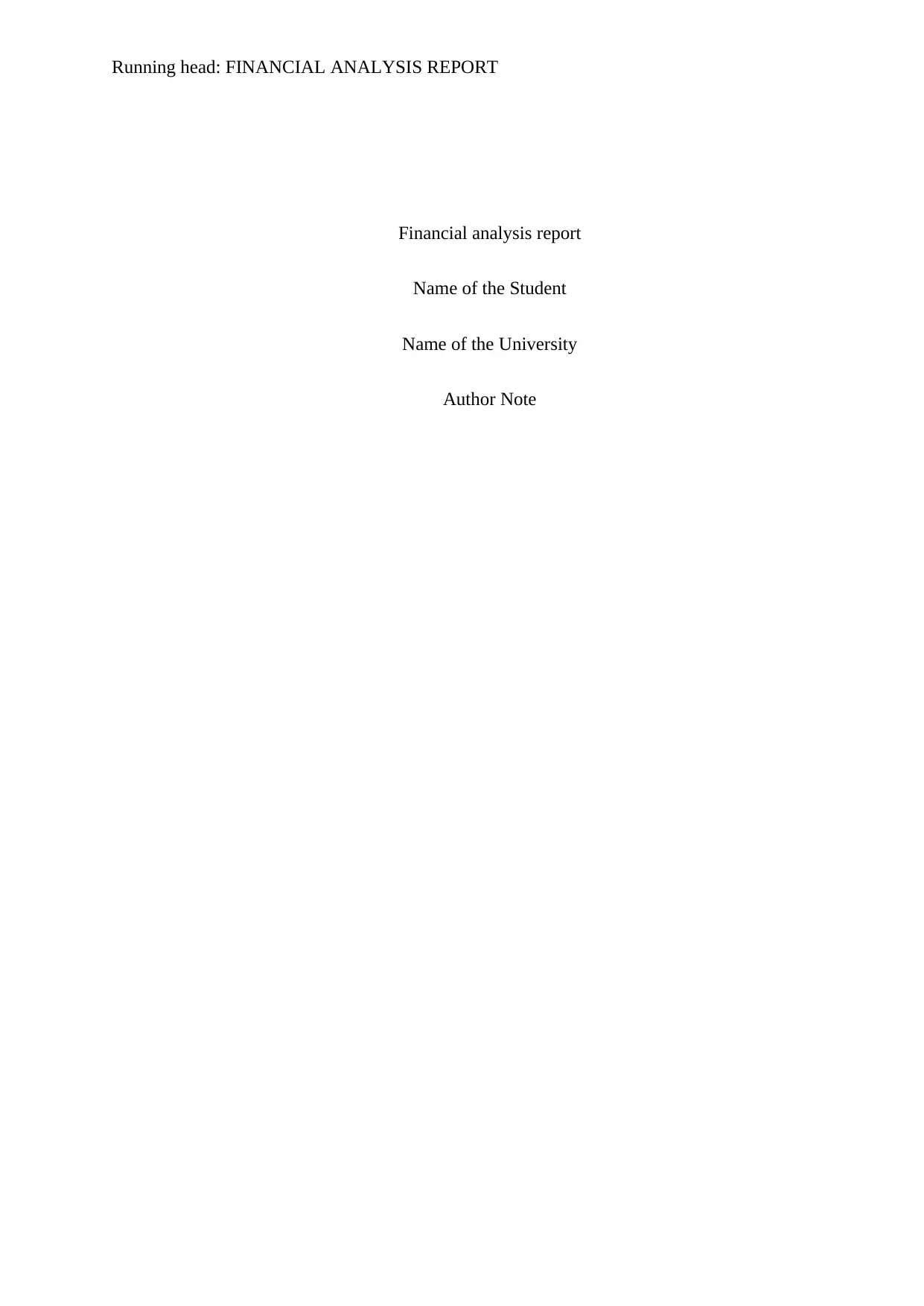
Running head: FINANCIAL ANALYSIS REPORT
Financial analysis report
Name of the Student
Name of the University
Author Note
Financial analysis report
Name of the Student
Name of the University
Author Note
Paraphrase This Document
Need a fresh take? Get an instant paraphrase of this document with our AI Paraphraser
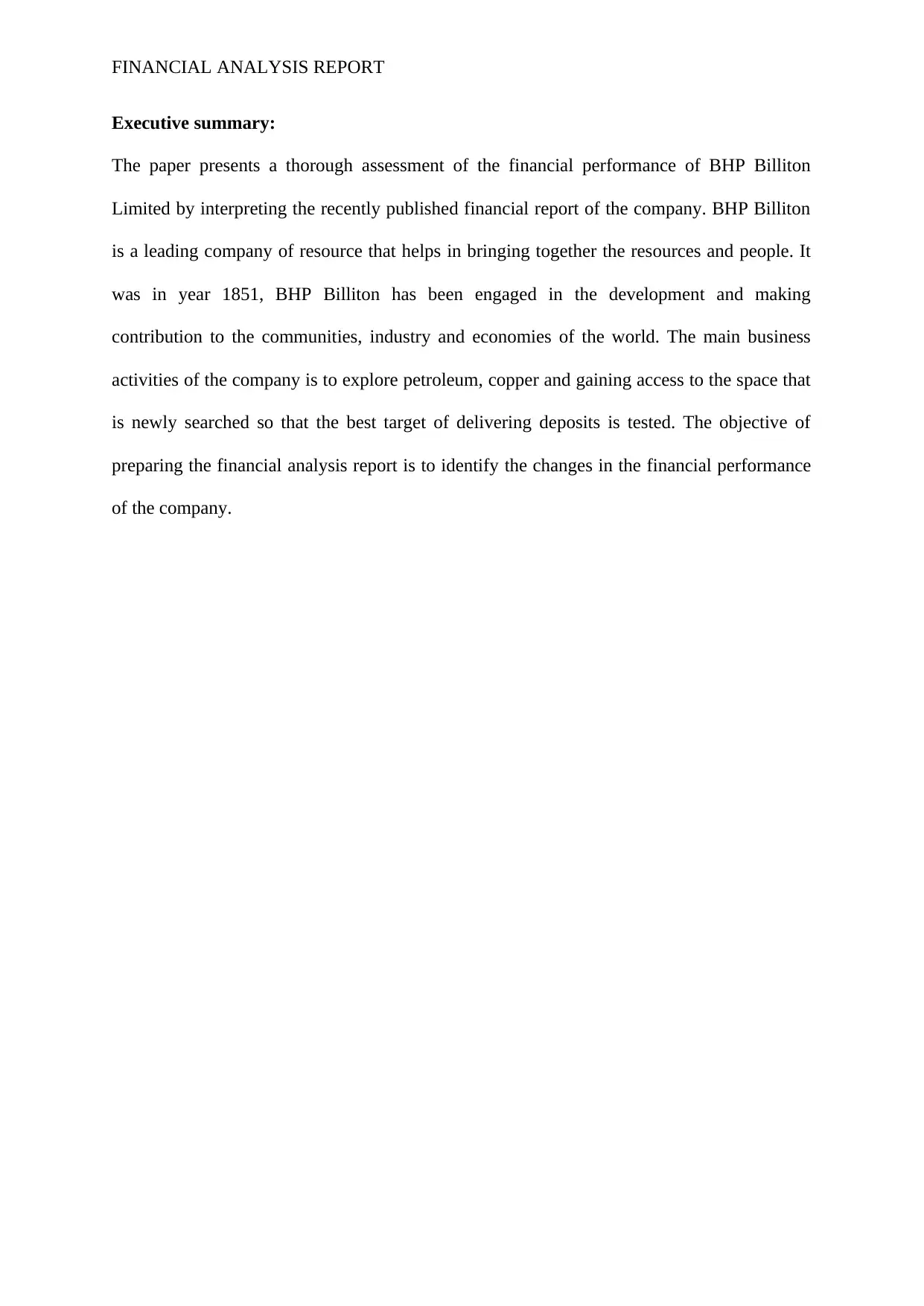
FINANCIAL ANALYSIS REPORT
Executive summary:
The paper presents a thorough assessment of the financial performance of BHP Billiton
Limited by interpreting the recently published financial report of the company. BHP Billiton
is a leading company of resource that helps in bringing together the resources and people. It
was in year 1851, BHP Billiton has been engaged in the development and making
contribution to the communities, industry and economies of the world. The main business
activities of the company is to explore petroleum, copper and gaining access to the space that
is newly searched so that the best target of delivering deposits is tested. The objective of
preparing the financial analysis report is to identify the changes in the financial performance
of the company.
Executive summary:
The paper presents a thorough assessment of the financial performance of BHP Billiton
Limited by interpreting the recently published financial report of the company. BHP Billiton
is a leading company of resource that helps in bringing together the resources and people. It
was in year 1851, BHP Billiton has been engaged in the development and making
contribution to the communities, industry and economies of the world. The main business
activities of the company is to explore petroleum, copper and gaining access to the space that
is newly searched so that the best target of delivering deposits is tested. The objective of
preparing the financial analysis report is to identify the changes in the financial performance
of the company.
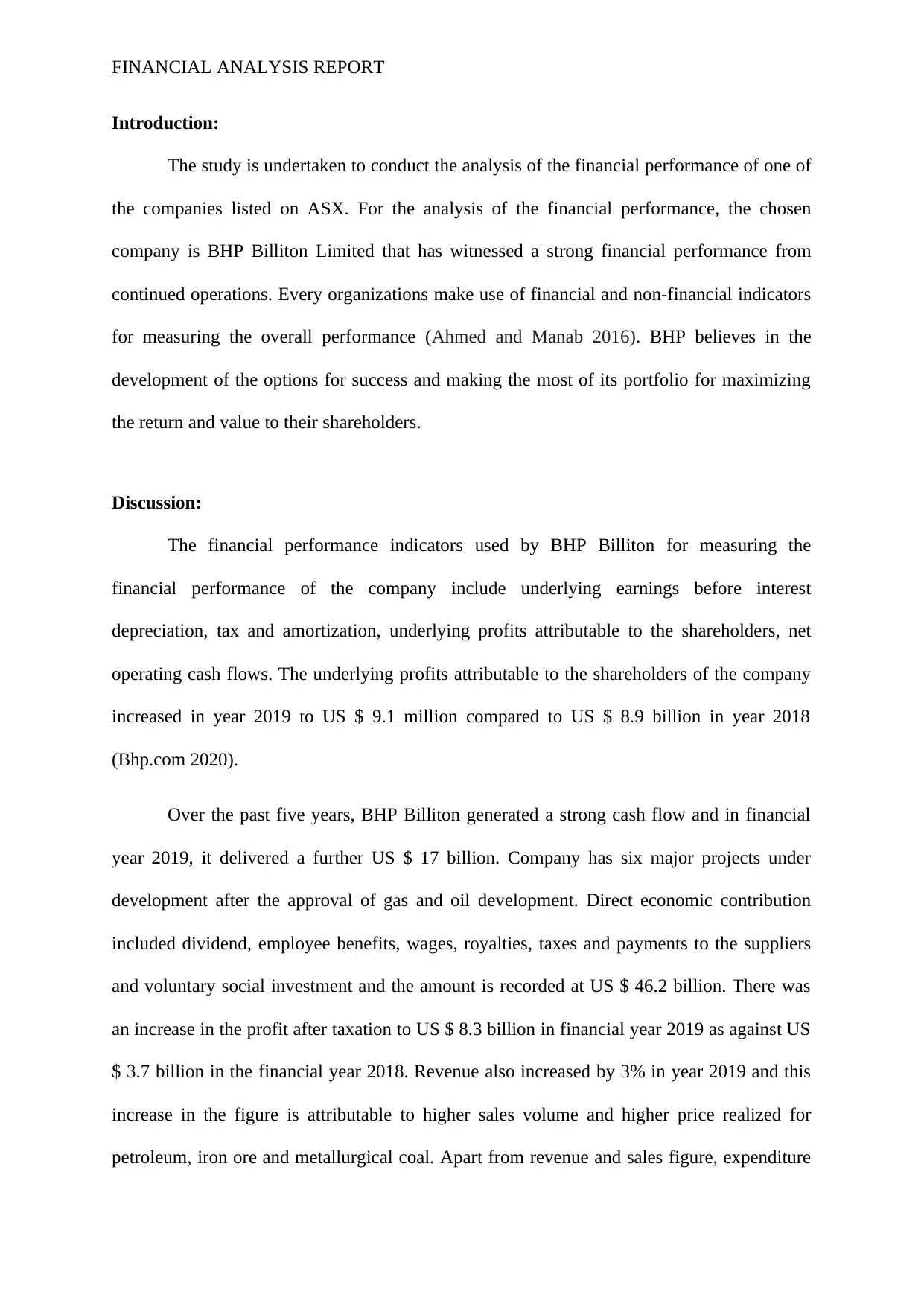
FINANCIAL ANALYSIS REPORT
Introduction:
The study is undertaken to conduct the analysis of the financial performance of one of
the companies listed on ASX. For the analysis of the financial performance, the chosen
company is BHP Billiton Limited that has witnessed a strong financial performance from
continued operations. Every organizations make use of financial and non-financial indicators
for measuring the overall performance (Ahmed and Manab 2016). BHP believes in the
development of the options for success and making the most of its portfolio for maximizing
the return and value to their shareholders.
Discussion:
The financial performance indicators used by BHP Billiton for measuring the
financial performance of the company include underlying earnings before interest
depreciation, tax and amortization, underlying profits attributable to the shareholders, net
operating cash flows. The underlying profits attributable to the shareholders of the company
increased in year 2019 to US $ 9.1 million compared to US $ 8.9 billion in year 2018
(Bhp.com 2020).
Over the past five years, BHP Billiton generated a strong cash flow and in financial
year 2019, it delivered a further US $ 17 billion. Company has six major projects under
development after the approval of gas and oil development. Direct economic contribution
included dividend, employee benefits, wages, royalties, taxes and payments to the suppliers
and voluntary social investment and the amount is recorded at US $ 46.2 billion. There was
an increase in the profit after taxation to US $ 8.3 billion in financial year 2019 as against US
$ 3.7 billion in the financial year 2018. Revenue also increased by 3% in year 2019 and this
increase in the figure is attributable to higher sales volume and higher price realized for
petroleum, iron ore and metallurgical coal. Apart from revenue and sales figure, expenditure
Introduction:
The study is undertaken to conduct the analysis of the financial performance of one of
the companies listed on ASX. For the analysis of the financial performance, the chosen
company is BHP Billiton Limited that has witnessed a strong financial performance from
continued operations. Every organizations make use of financial and non-financial indicators
for measuring the overall performance (Ahmed and Manab 2016). BHP believes in the
development of the options for success and making the most of its portfolio for maximizing
the return and value to their shareholders.
Discussion:
The financial performance indicators used by BHP Billiton for measuring the
financial performance of the company include underlying earnings before interest
depreciation, tax and amortization, underlying profits attributable to the shareholders, net
operating cash flows. The underlying profits attributable to the shareholders of the company
increased in year 2019 to US $ 9.1 million compared to US $ 8.9 billion in year 2018
(Bhp.com 2020).
Over the past five years, BHP Billiton generated a strong cash flow and in financial
year 2019, it delivered a further US $ 17 billion. Company has six major projects under
development after the approval of gas and oil development. Direct economic contribution
included dividend, employee benefits, wages, royalties, taxes and payments to the suppliers
and voluntary social investment and the amount is recorded at US $ 46.2 billion. There was
an increase in the profit after taxation to US $ 8.3 billion in financial year 2019 as against US
$ 3.7 billion in the financial year 2018. Revenue also increased by 3% in year 2019 and this
increase in the figure is attributable to higher sales volume and higher price realized for
petroleum, iron ore and metallurgical coal. Apart from revenue and sales figure, expenditure
⊘ This is a preview!⊘
Do you want full access?
Subscribe today to unlock all pages.

Trusted by 1+ million students worldwide
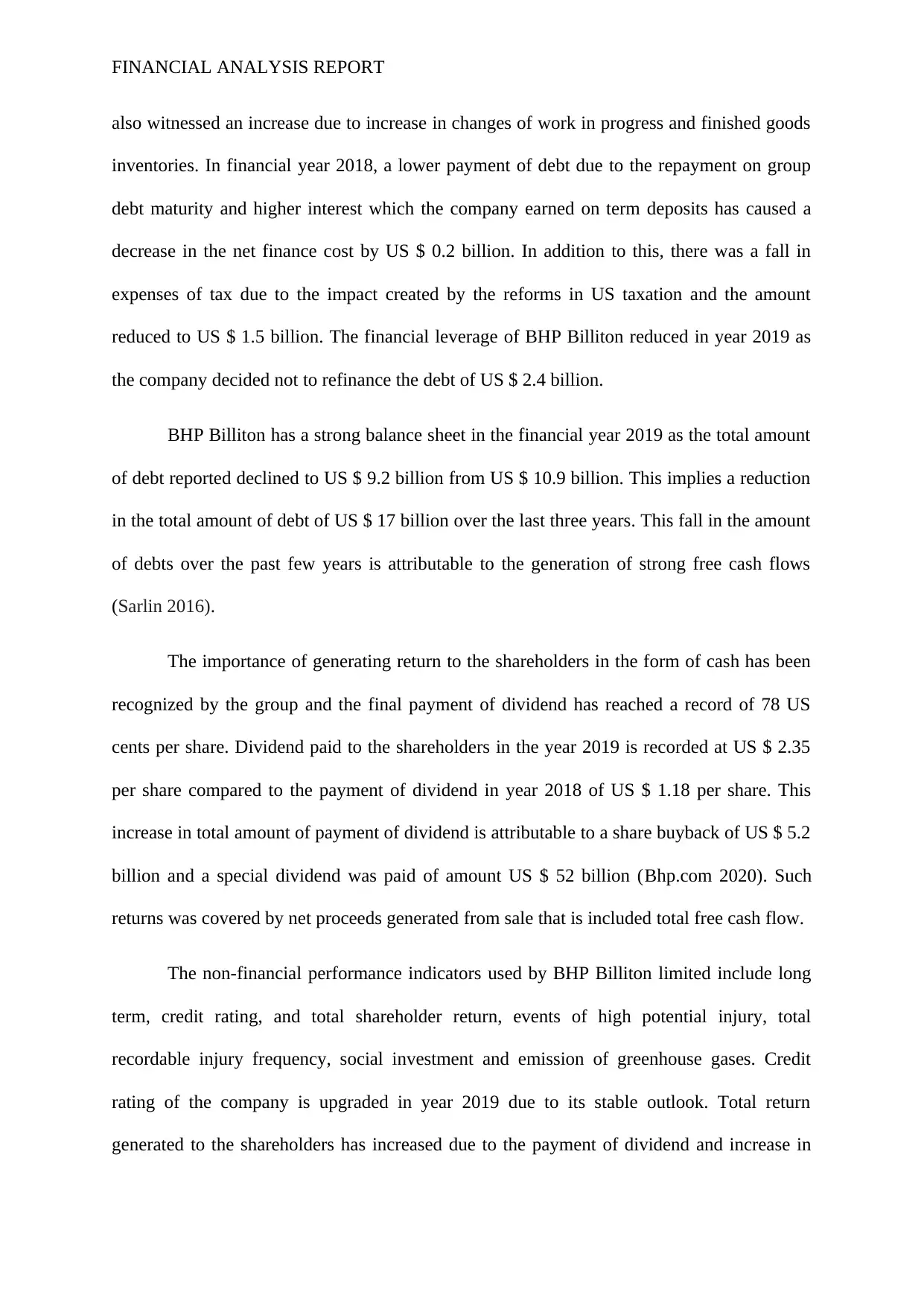
FINANCIAL ANALYSIS REPORT
also witnessed an increase due to increase in changes of work in progress and finished goods
inventories. In financial year 2018, a lower payment of debt due to the repayment on group
debt maturity and higher interest which the company earned on term deposits has caused a
decrease in the net finance cost by US $ 0.2 billion. In addition to this, there was a fall in
expenses of tax due to the impact created by the reforms in US taxation and the amount
reduced to US $ 1.5 billion. The financial leverage of BHP Billiton reduced in year 2019 as
the company decided not to refinance the debt of US $ 2.4 billion.
BHP Billiton has a strong balance sheet in the financial year 2019 as the total amount
of debt reported declined to US $ 9.2 billion from US $ 10.9 billion. This implies a reduction
in the total amount of debt of US $ 17 billion over the last three years. This fall in the amount
of debts over the past few years is attributable to the generation of strong free cash flows
(Sarlin 2016).
The importance of generating return to the shareholders in the form of cash has been
recognized by the group and the final payment of dividend has reached a record of 78 US
cents per share. Dividend paid to the shareholders in the year 2019 is recorded at US $ 2.35
per share compared to the payment of dividend in year 2018 of US $ 1.18 per share. This
increase in total amount of payment of dividend is attributable to a share buyback of US $ 5.2
billion and a special dividend was paid of amount US $ 52 billion (Bhp.com 2020). Such
returns was covered by net proceeds generated from sale that is included total free cash flow.
The non-financial performance indicators used by BHP Billiton limited include long
term, credit rating, and total shareholder return, events of high potential injury, total
recordable injury frequency, social investment and emission of greenhouse gases. Credit
rating of the company is upgraded in year 2019 due to its stable outlook. Total return
generated to the shareholders has increased due to the payment of dividend and increase in
also witnessed an increase due to increase in changes of work in progress and finished goods
inventories. In financial year 2018, a lower payment of debt due to the repayment on group
debt maturity and higher interest which the company earned on term deposits has caused a
decrease in the net finance cost by US $ 0.2 billion. In addition to this, there was a fall in
expenses of tax due to the impact created by the reforms in US taxation and the amount
reduced to US $ 1.5 billion. The financial leverage of BHP Billiton reduced in year 2019 as
the company decided not to refinance the debt of US $ 2.4 billion.
BHP Billiton has a strong balance sheet in the financial year 2019 as the total amount
of debt reported declined to US $ 9.2 billion from US $ 10.9 billion. This implies a reduction
in the total amount of debt of US $ 17 billion over the last three years. This fall in the amount
of debts over the past few years is attributable to the generation of strong free cash flows
(Sarlin 2016).
The importance of generating return to the shareholders in the form of cash has been
recognized by the group and the final payment of dividend has reached a record of 78 US
cents per share. Dividend paid to the shareholders in the year 2019 is recorded at US $ 2.35
per share compared to the payment of dividend in year 2018 of US $ 1.18 per share. This
increase in total amount of payment of dividend is attributable to a share buyback of US $ 5.2
billion and a special dividend was paid of amount US $ 52 billion (Bhp.com 2020). Such
returns was covered by net proceeds generated from sale that is included total free cash flow.
The non-financial performance indicators used by BHP Billiton limited include long
term, credit rating, and total shareholder return, events of high potential injury, total
recordable injury frequency, social investment and emission of greenhouse gases. Credit
rating of the company is upgraded in year 2019 due to its stable outlook. Total return
generated to the shareholders has increased due to the payment of dividend and increase in
Paraphrase This Document
Need a fresh take? Get an instant paraphrase of this document with our AI Paraphraser
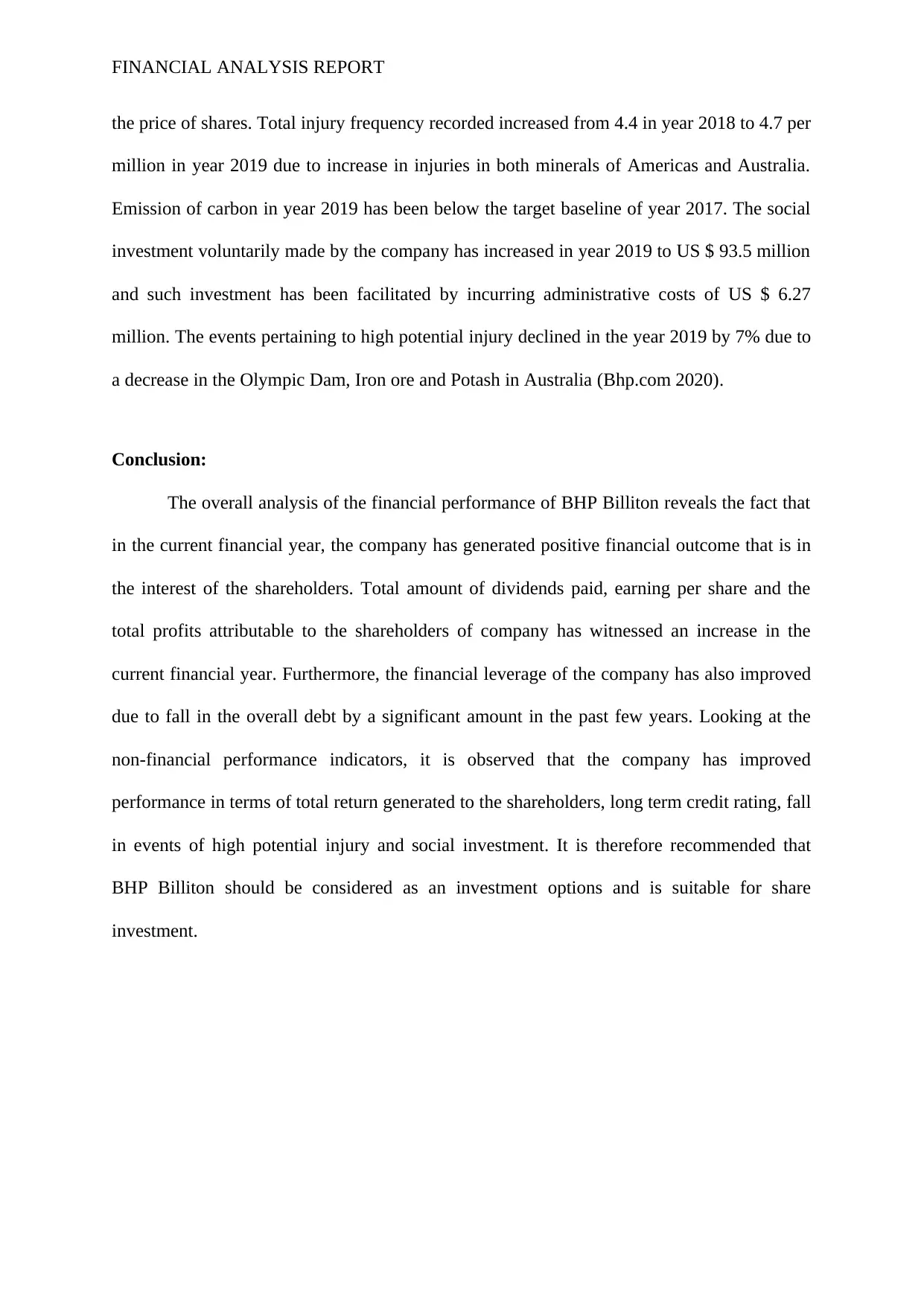
FINANCIAL ANALYSIS REPORT
the price of shares. Total injury frequency recorded increased from 4.4 in year 2018 to 4.7 per
million in year 2019 due to increase in injuries in both minerals of Americas and Australia.
Emission of carbon in year 2019 has been below the target baseline of year 2017. The social
investment voluntarily made by the company has increased in year 2019 to US $ 93.5 million
and such investment has been facilitated by incurring administrative costs of US $ 6.27
million. The events pertaining to high potential injury declined in the year 2019 by 7% due to
a decrease in the Olympic Dam, Iron ore and Potash in Australia (Bhp.com 2020).
Conclusion:
The overall analysis of the financial performance of BHP Billiton reveals the fact that
in the current financial year, the company has generated positive financial outcome that is in
the interest of the shareholders. Total amount of dividends paid, earning per share and the
total profits attributable to the shareholders of company has witnessed an increase in the
current financial year. Furthermore, the financial leverage of the company has also improved
due to fall in the overall debt by a significant amount in the past few years. Looking at the
non-financial performance indicators, it is observed that the company has improved
performance in terms of total return generated to the shareholders, long term credit rating, fall
in events of high potential injury and social investment. It is therefore recommended that
BHP Billiton should be considered as an investment options and is suitable for share
investment.
the price of shares. Total injury frequency recorded increased from 4.4 in year 2018 to 4.7 per
million in year 2019 due to increase in injuries in both minerals of Americas and Australia.
Emission of carbon in year 2019 has been below the target baseline of year 2017. The social
investment voluntarily made by the company has increased in year 2019 to US $ 93.5 million
and such investment has been facilitated by incurring administrative costs of US $ 6.27
million. The events pertaining to high potential injury declined in the year 2019 by 7% due to
a decrease in the Olympic Dam, Iron ore and Potash in Australia (Bhp.com 2020).
Conclusion:
The overall analysis of the financial performance of BHP Billiton reveals the fact that
in the current financial year, the company has generated positive financial outcome that is in
the interest of the shareholders. Total amount of dividends paid, earning per share and the
total profits attributable to the shareholders of company has witnessed an increase in the
current financial year. Furthermore, the financial leverage of the company has also improved
due to fall in the overall debt by a significant amount in the past few years. Looking at the
non-financial performance indicators, it is observed that the company has improved
performance in terms of total return generated to the shareholders, long term credit rating, fall
in events of high potential injury and social investment. It is therefore recommended that
BHP Billiton should be considered as an investment options and is suitable for share
investment.
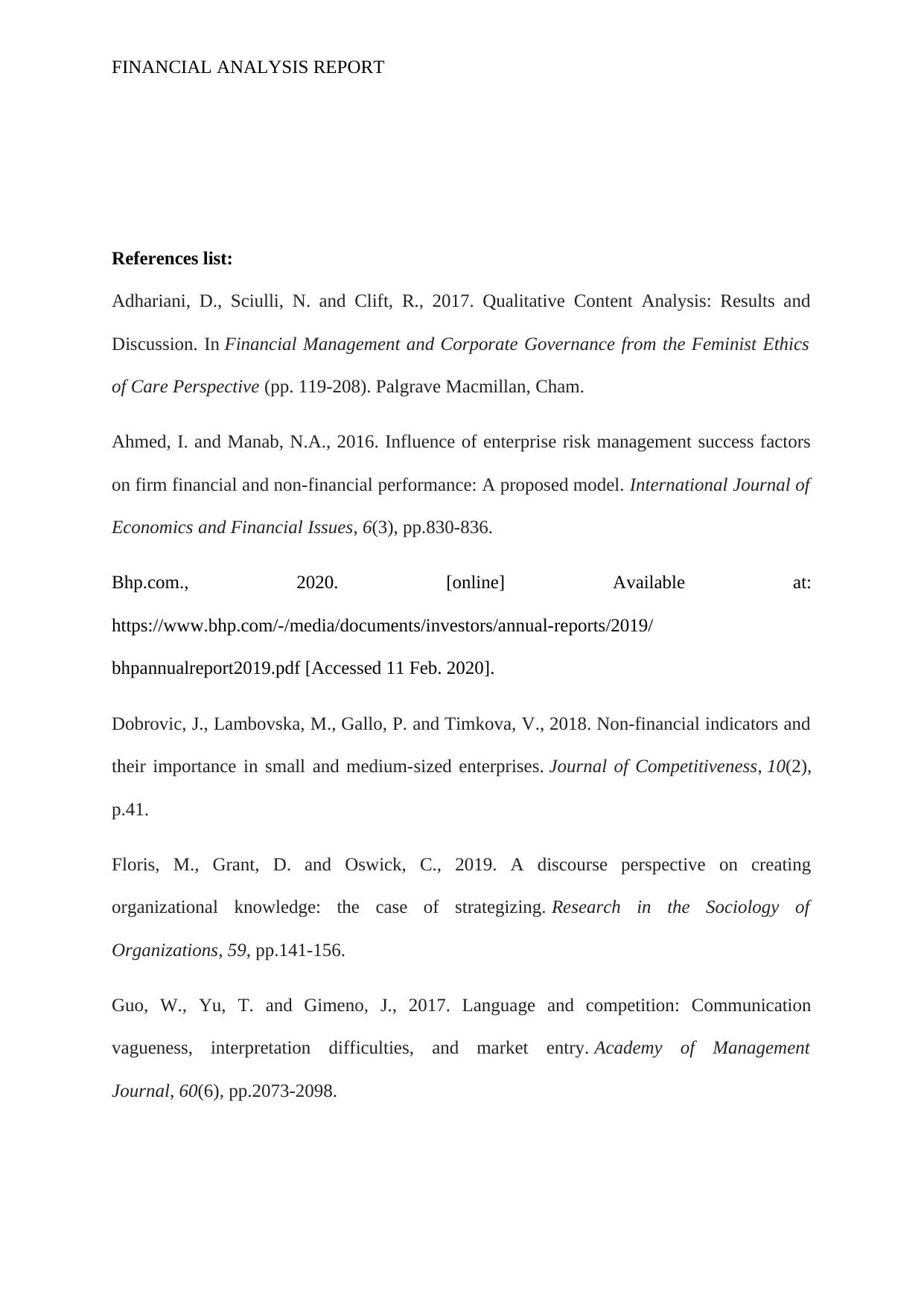
FINANCIAL ANALYSIS REPORT
References list:
Adhariani, D., Sciulli, N. and Clift, R., 2017. Qualitative Content Analysis: Results and
Discussion. In Financial Management and Corporate Governance from the Feminist Ethics
of Care Perspective (pp. 119-208). Palgrave Macmillan, Cham.
Ahmed, I. and Manab, N.A., 2016. Influence of enterprise risk management success factors
on firm financial and non-financial performance: A proposed model. International Journal of
Economics and Financial Issues, 6(3), pp.830-836.
Bhp.com., 2020. [online] Available at:
https://www.bhp.com/-/media/documents/investors/annual-reports/2019/
bhpannualreport2019.pdf [Accessed 11 Feb. 2020].
Dobrovic, J., Lambovska, M., Gallo, P. and Timkova, V., 2018. Non-financial indicators and
their importance in small and medium-sized enterprises. Journal of Competitiveness, 10(2),
p.41.
Floris, M., Grant, D. and Oswick, C., 2019. A discourse perspective on creating
organizational knowledge: the case of strategizing. Research in the Sociology of
Organizations, 59, pp.141-156.
Guo, W., Yu, T. and Gimeno, J., 2017. Language and competition: Communication
vagueness, interpretation difficulties, and market entry. Academy of Management
Journal, 60(6), pp.2073-2098.
References list:
Adhariani, D., Sciulli, N. and Clift, R., 2017. Qualitative Content Analysis: Results and
Discussion. In Financial Management and Corporate Governance from the Feminist Ethics
of Care Perspective (pp. 119-208). Palgrave Macmillan, Cham.
Ahmed, I. and Manab, N.A., 2016. Influence of enterprise risk management success factors
on firm financial and non-financial performance: A proposed model. International Journal of
Economics and Financial Issues, 6(3), pp.830-836.
Bhp.com., 2020. [online] Available at:
https://www.bhp.com/-/media/documents/investors/annual-reports/2019/
bhpannualreport2019.pdf [Accessed 11 Feb. 2020].
Dobrovic, J., Lambovska, M., Gallo, P. and Timkova, V., 2018. Non-financial indicators and
their importance in small and medium-sized enterprises. Journal of Competitiveness, 10(2),
p.41.
Floris, M., Grant, D. and Oswick, C., 2019. A discourse perspective on creating
organizational knowledge: the case of strategizing. Research in the Sociology of
Organizations, 59, pp.141-156.
Guo, W., Yu, T. and Gimeno, J., 2017. Language and competition: Communication
vagueness, interpretation difficulties, and market entry. Academy of Management
Journal, 60(6), pp.2073-2098.
⊘ This is a preview!⊘
Do you want full access?
Subscribe today to unlock all pages.

Trusted by 1+ million students worldwide

FINANCIAL ANALYSIS REPORT
Sarlin, P., 2016. Macroprudential oversight, risk communication and visualization. Journal of
Financial Stability, 27, pp.160-179.
Spiegelhalter, D., 2017. Risk and uncertainty communication. Annual Review of Statistics
and Its Application, 4, pp.31-60.
Sarlin, P., 2016. Macroprudential oversight, risk communication and visualization. Journal of
Financial Stability, 27, pp.160-179.
Spiegelhalter, D., 2017. Risk and uncertainty communication. Annual Review of Statistics
and Its Application, 4, pp.31-60.
1 out of 7
Related Documents
Your All-in-One AI-Powered Toolkit for Academic Success.
+13062052269
info@desklib.com
Available 24*7 on WhatsApp / Email
![[object Object]](/_next/static/media/star-bottom.7253800d.svg)
Unlock your academic potential
Copyright © 2020–2025 A2Z Services. All Rights Reserved. Developed and managed by ZUCOL.



